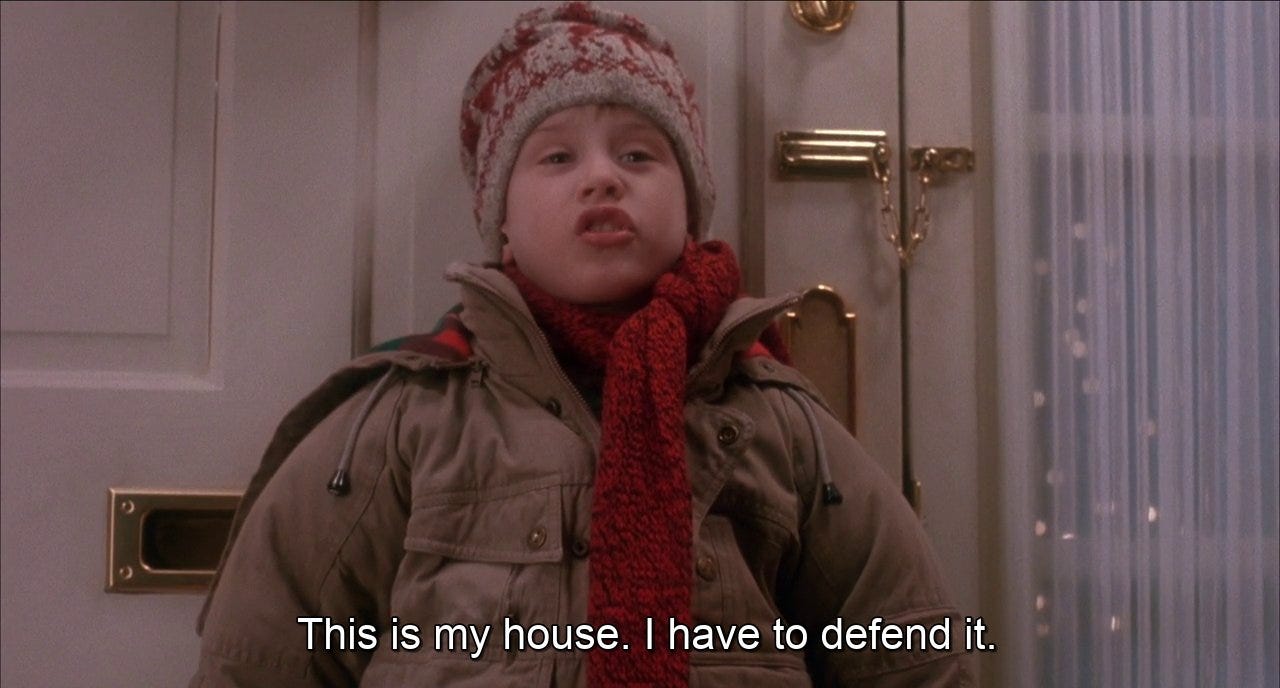🪤 #196 - It's A Trap!
"The trap isn't a trap if you know the trap is trying to trap you. It's a face-off." -Peter Quill
Whether they’re as simple as a mousetrap, or complex as a Rube Goldberg device, traps are a type of delayed combat in stories. Traps act as a highly visual form of cause and effect, engaging an audience with just enough knowledge of what could go wrong to keep them on the edge of their seats.
In a classic example of heroes confronting a trap, The Goonies gives a clear setup to this sequence:
Some instructions for how the trap might work
Someone in the group understands part of the instructions
The ticking clock of the bad guys getting closer (with murderous intent)
What we don’t know right away is what will happen if they fail to disarm the trap properly:
This skeletal pipe organ creates a clear obstacle for the team, shows us what’s at stake (giant pits open up if they play the wrong notes), and there are clear win and lose conditions.
Traps can also reveal character, and can play out differently depending on where we are in the story. The opening sequence of Raiders of the Lost Ark has Indiana Jones navigating a series of traps where he’s one step ahead of the viewer in his knowledge of what to do (and he doesn’t feel like stopping to explain much):
Compare that to the climax of Indiana Jones and the Last Crusade, where tension is heightened by slowing down the pace and playing into the audiences hope that Indy will decipher the clues to get to the Holy Grail (and their fear that he’ll meet a gruesome death):
Compared to Raiders, each one of these traps is given a description that sets up the clue, and a sense of thematic connection between the obstacles and the reward waiting beyond them.
Sometimes a story can go all in on a heroic failure to not trip the trap. Take the example of Dungeons & Dragons: Honor Among Thieves and the Gnome Bridge, which gets a lengthy setup for how difficult it will be to overcome:
The failure to overcome the trap doesn’t lead to instant death, but creates a new obstacle. It also plays with audience expectations. As an example, check out SteelySam’s video where he attempts to use the existing clues to figure out what successfully crossing the bridge would look like.
But sometimes heroes need to set the traps, like Nancy Thompson in A Nightmare on Elm Street:
Shannon Keating writes about the resourcefulness and intelligence of Nancy, and how labelling her as a Final Girl doesn’t respect the complexities of her character. Fiyero3305 shares more admiration for Nancy’s ingenuity and bravery, contrasting her with another famous horror heroine:
I remember a documentary about the John Carpenter classic Halloween in which it was mentioned that he had his final girl turn away from the killer and drop her weapon to indicate that she is not a killer, that she is still innocent despite what she’s gone through. I can appreciate that, but I think it’s so much more realistic and satisfying to see someone who has been affected by what she’s gone through. Nancy isn’t concerned with being a “good” girl, she’s concerned with being a live girl…
We can’t talk about setting traps and film without touching on Home Alone. There are decades of precedent establishing this.
The journal Interiors takes an architectural view of Kevin’s traps, and considers the importance of how Kevin sequences the traps and anticipates Harry and Marv’s plan of attack. Lauren Hansen speaks with a doctor to answer the question about how badly injured the Wet Bandits would be if the film hadn’t established its Looney Tunes Physics. And from McCallister House, a collection of notes on the behind the scenes work needed to create the camera angles, props, and stunt work for the trap sequence.
👋 Are you new here?
Inneresting is a weekly newsletter about writing and things that are interesting to writers. Subscribe now to get more Inneresting things sent to your inbox.
Getting yourself out of (writing) traps
This week’s issue is brought to you by It’s A Trap!, card number 47 in the Writer Emergency Pack XL deck:
Heroes can set traps or be the victims. Either way, traps take planning.
The Writer Emergency Pack XL deck was made with one goal: Help writers get unstuck when something stalls in their story.
To find out more about the writing prompts on the 52 cards in the XL deck, check out the Writer Emergency site.
Previously on Inneresting…
In case you missed it, in last issue’s most clicked link Mike Langley gives a voice to The New York Times paywall.
What else is inneresting?
Rachel M. Cohen puts a spotlight on communities converting abandoned malls into housing.
I have never wanted a 3D printer more than this: Scott Yu-Jan designs an iPad stand that sits atop a Mac Studio and looks like a classic Macintosh.
Henrik Karlsson on rejecting the pace of a content farm and learning to slow down and revise.
And that’s what’s inneresting this week!
Inneresting is edited by Chris Csont, with contributions from readers like you and the entire Quote-Unquote team.
Are you enjoying this newsletter?
📧 Forward it to a friend and suggest they check it out.
🔗 Share a link to this post on social media.
🗣 Have ideas for future topics (or just want to say hello)? Reach out to Chris via email at inneresting@johnaugust.com, Mastodon @ccsont@mastodon.art, or Bluesky @ccsont.bsky.social






